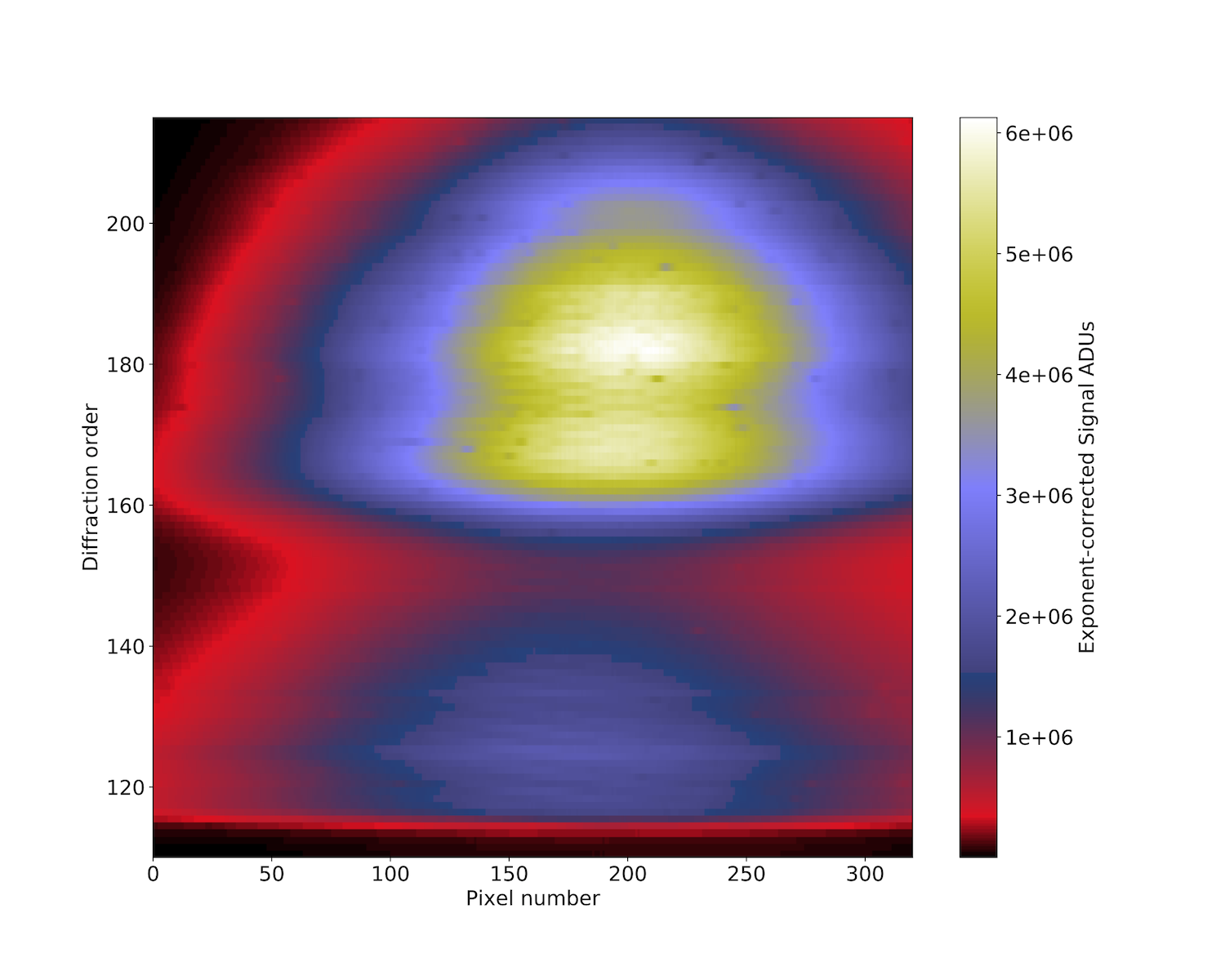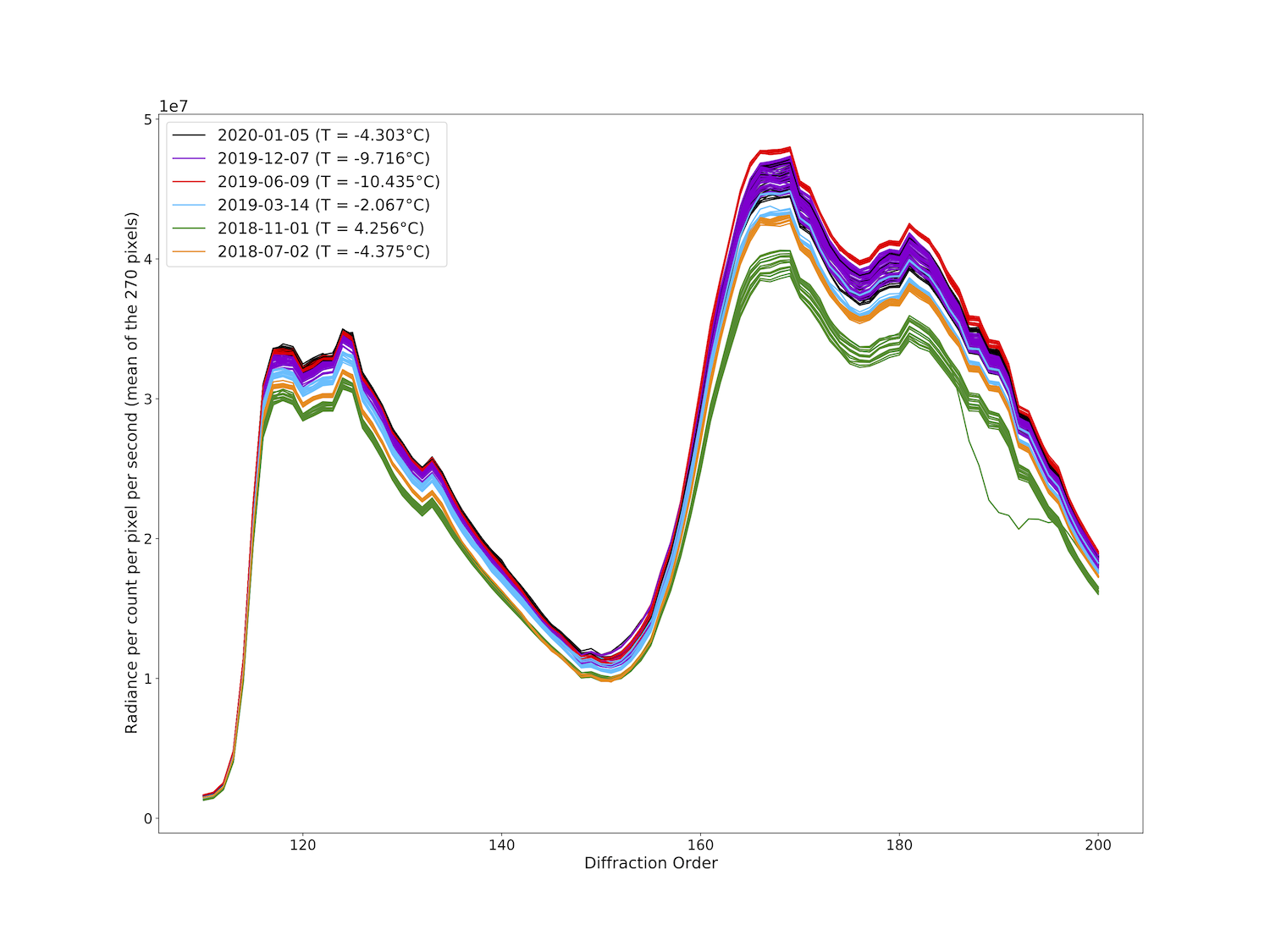Calibration of the NOMAD-LNO channel onboard ExoMars 2016 Trace Gas Orbiter using solar spectra
- Université Paris-Saclay, CNRS, GEOPS, 91405, Orsay, France (guillaume.cruz-mermy@universite-paris-saclay.fr)
Calibration of the NOMAD-LNO channel onboard ExoMars 2016 Trace Gas Orbiter using solar spectra
Cruz Mermy (1), F. Schmidt (1), I. R. Thomas (2), F. Daerden (2), B. Ristic (2), M. R. Patel (3,4), J.-J. Lopez-Moreno (5), G. Bellucci (6), A. C. Vandaele (2) and the NOMAD Team
Introduction
The LNO channel is a compact high-resolution echelle grating spectrometer with an acousto-optic tunable filter (AOTF) working in the infrared domain from 2.3 μ m to 3.8 μ m (4250-2630 cm -1 ) with a resolving power ( λ / Δ λ ) of around 10000, specially designed for nadir observation. With such high resolving power combined with the near-circular orbit of TGO that allow completion of 12 orbits in one sol, promoting a global coverage of the planet, the NOMAD-LNO instrument fits in with the science objective of the ExoMars program [Vandaele2015, Vandaele2018] and is perfectly suited to study the martian surface and atmosphere. The main objective here is to propose an original calibration procedure, adaptable for the full dataset of NOMAD-LNO. This calibration is complementary to the one proposed by [I.R.Thomas2021] in the sense that we will not assume the temporal stability of the instrument here. Our approach is thus able to test the temporal stability of the instrument in front of degradation by energetic particles. This approach will be based on an empirical continuum removal to take into account the departure between actual blaze function and theoretical one.
Dataset
The NOMAD-LNO fullscans is a solar observation made for calibration purposes. The instrument, normally in nadir position, is pointing toward the sun. The choice of using solar fullscans was made for two reasons: first, there are not enough miniscans to cover all diffraction orders with a significant amount of data while fullscans always cover the whole spectral range which allows testing the time dependence of the calibration. Second, it is important to estimate the instrumental sensitivity over the whole diffraction order range. As of June 2020, six solar calibrations have been performed. Typical fullscan observation is shown in figure 1 the x-axis is the spectel number, the y-axis is the diffraction order (i.e. the AOTF frequency) and the z-axis shows the sensitivity of the detector (in ADU for Analog to Digital Units).

Figure 1- Example of a typical NOMAD-LNO solar fullscan (observation of 2019-03-14).
Method
The calibration aims to build a model to estimate the spectral conversion (wavenumbers in cm -1 for each spectels of the detector) and the photometric sensitivity (conversion factor from ADU to spectral radiance). The model must be versatile enough to face the uncertainties of some instrumental functions, such as the AOTF transfer function and the grating blaze function. The method used here is based on the usual comparison between a real solar observation and a simulated solar spectrum. The observation is LNO solar fullscans and we aim to simulate the same observation by accounting for the AOTF and grating effects using the synthetic solar spectrum. The comparison is done after spectra continuum correction to work out the baseline uncertainties. This approach is of particular importance for correct calibration of nadir data, for which there is no observation free of atmospheric absorption [Liuzzi2019]. The calibration steps we perform are the following :
- First-order spectral calibration: conversion of detector spectel number and diffraction order to wavenumber
- Calibration inversion, by minimizing the residue between observation and simulation, following these steps:
- Application of the grating blaze function and AOTF transfer function shape
- Simulation of the Instrument Line Shape (ILS)
- Integration of a residual wavenumber shift
- Continuum removal to remove the shape imposed by the instrumental functions
- Normalization and estimation of the sensitivity
- Computation of the residue
- By construction, the result of the minimization leads to the estimation of the instrumental sensitivity
Results
The main objective of the model is to establish the conversion factor from the measured ADU by the detector to spectral radiance. This step is done on all spectra of all fullscan so that we can look at the potential variations of this factor during the mission. Figure 2 shows the sensitivity curves of the LNO channel estimated estimate for each fullscans. These differences between fullscans can be explained in many ways and one of the advantages of this calibration method is to be able to test the dependence of the sensitivity such as a function of time, of the Mars-Sun distance, or the temperature. Here we demonstrate that temperature dependence is the dominant one. Looking at all sequences together, we found a linear relationship for each diffraction order that can be used to correct the temperature when calibrating any nadir observations.
Figure 2 - Radiance to counts conversion for diffraction orders 110 to 200 retrieved from the calibration.
Conclusion
We propose an alternative calibration method for the LNO data using reference solar spectra with the advantage to estimate temporal and temperature dependence. The method is based on the adjustment of a synthetic spectrum to the solar data acquired with NOMAD-LNO fullscan operation mode, which allows a calibration over the whole spectral range of the instrument (different orders), using an analytical model that simulate the instrumental effects. To realize this calibration, we propose to focus on the level and the fine solar bands shape and remove the continuum. This strategy allows to correct of unknowns in the instrumental AOTF/blaze functions but could possibly remove the large spectral feature of the order. However, by performing the same continuum removal to the synthetic data, it is possible to compare synthetic and observation data without bias [Villanueva2021, Knutsen2021]. In addition, this method makes it possible to test the correlations between sensitivity and instrumental parameters (AOTF shape, ILS, wavenumber shift), such as temperature and time. By doing this, we show that there is at first degree a linear relationship between the temperature and the sensitivity. By removing this effect, we demonstrated that there is no sign of temporal change in the sensitivity, which validates the calibration method proposed by Thomas et al, 2021. If any temporal variations of the detector occur in the future, our method should be able to capture them.
How to cite: Cruz Mermy, G.: Calibration of the NOMAD-LNO channel onboard ExoMars 2016 Trace Gas Orbiter using solar spectra, Europlanet Science Congress 2021, online, 13–24 Sep 2021, EPSC2021-708, https://doi.org/10.5194/epsc2021-708, 2021.

